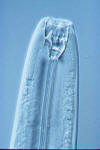 |
The predaceous nematode Odontopharynx longicaudata (Diplogastrida: Odontopharyngidae). Photo by J. Chitamber |
 |
The predaceous nematode Odontopharynx longicaudata Photo by J. Chitamber |
Rev. 02/26/24
characterized by movable teeth in stoma;
predators, omnivores, bacterial and fungal feeders, insect associates;
very muscular metacorpus and glandular postcorpus;
individuals may connect with others at tail tip in water to form a ball of nematodes
A note on the name of the order, suborder, superfamily, family and subfamily:
Schultz (in Carus, 1857) erected and described the genus Diplogaster. Through various taxonomic revisions and classification schemes, names at different levels of resolution were derived from the genus name. Hence, Diplogasterida, Diplogasterina, Diplogasteroidea, Diplogasteridae and Diplogasterinae appear in the earlier (and some recent literature) as, respectively, names for order, suborder, superfamily, family and subfamily. Baker and Sanwal (1969) pointed out that the possesive case for the word ending "gaster" would be "gastros", so that the latinized family name would have the ending "gastridae", not "gasteridae" and likewise for the names of the other taxonomic categories. Hence, in concordance with the International Code of Zoological Nomenclature, the correct usage of the names is Diplogastrida, Diplogastrina, Diplogastroidea, Diplogastridae and Diplogastrinae.
Interestingly, the family and subfamily names Diplogasteroididae and Diplogasteroidinae, derived from the genus name Diplogasteroides are unchanged, presumably because the possessive case is based on the word ending "oid" rather than "er".
Modern Phylogenies:
The Order Diplogastrida is considered a suborder (Diplogastrina) of the Rhabditida by Andrassy (2005) and as the superfamily Diplogastroidea within the suborder Rhabditina of the order Rhabditida by DeLey and Blaxter (2002, 2004) and DeLey et al. (2006).
Genera in the Diplogastrida (or Diplogastrina or Diplogastroidea) include:
|
Andassy, I. (2005) Free-living Nematodes of Hungary, Part I. (Nematoda errantia). Hungarian Natural History Museum 518p.
Baker, A.D. and Sanwal, K.C. 1969. Some notes on nomenclature (Nematoda). Journal of Helminthology 18:363-366.
Carus, J.V. 1857. Icones zootomicae. Rste Halfte: Die wirbellosen Thiere 1pp.
De Ley, P. and Blaxter. M. 2002. Systematic position and phylogeny. In: D. L. Lee (ed) The Biology of Nematodes.
De Ley, P. and Blaxter. M. 2004. A new system for Nematoda: combining morphological characters with molecular trees, and translating clades into ranks and taxa. Nematology Monographs and Perspectives, 2004: 633-653.
De Ley, P., Decraemer, W. & Eyualem-Abebe.
(2006). Introduction, summary of present knowledge and research addressing the
ecology and taxonomy of freshwater nematodes. Pp 3-30 in Eyualem-Abebe, Andrássy,
I. & Traunspurger, W. (Eds). Freshwater
Nematodes, Ecology and Taxonomy.
CABI Publishing,
Wallingford, UK.